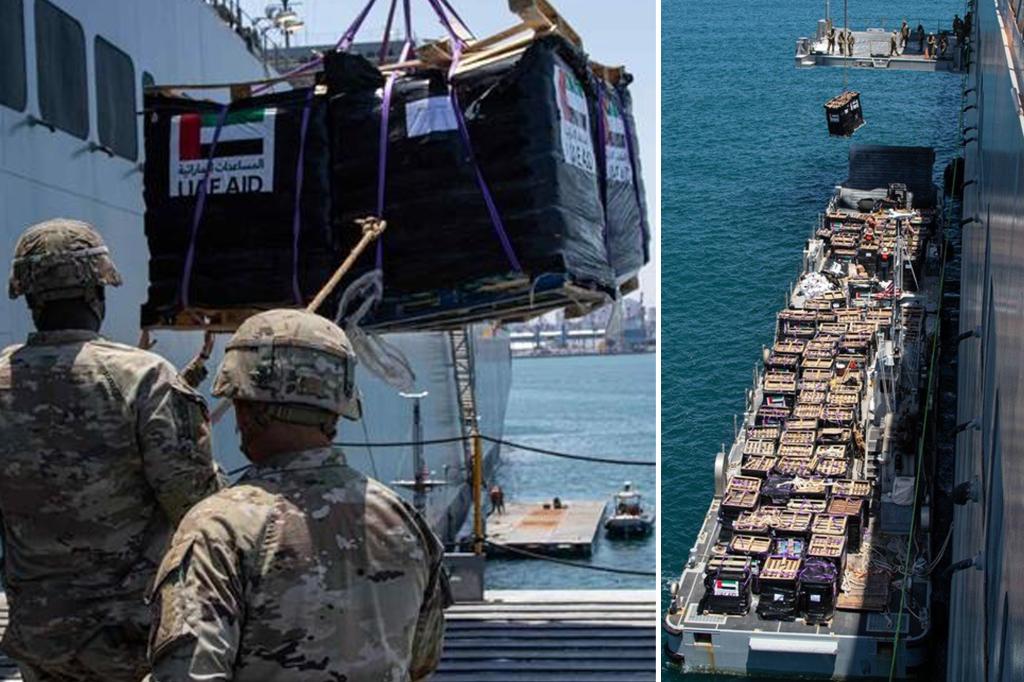

Aid groups have begun distributing the humanitarian assistance offloaded at the US pier in Gaza to Palestinians, after encountering significant obstacles on distribution routes including Hamas drones and looting that delayed the deliveries.
More than 500 metric tons of food and other humanitarian aid offloaded at the pier has now been handed off to humanitarian partners, and two-thirds of that aid has distributed to or is in the process of reaching those in need, a top US Agency for International Development (USAID) official told reporters on a call Thursday.
The distribution comes several days after the US military’s pier operation launched and got off to a rocky start.
Aid deliveries from the pier to warehouses inside Gaza were initially hindered by a Hamas drone attack on the IDF “several miles away” from the pier that led to a freeze on convoy movements, and some trucks were looted along one of the distribution paths earlier this week, Vice Admiral Brad Cooper, the deputy commander of United States Central Command, said in a call with reporters on Thursday.
As a result, the US military had to help USAID come up with alternative, safer routes for trucks leaving the marshaling area on the beach near the pier and traveling to the warehouses.
“Such challenges with internal distribution are not new or unique to aid delivery from the sea,” Cooper said. “But these atmospherics, I think, give you some sense of the operating environment.”
More than 1,000 US troops helped to build the humanitarian pier and causeway off the coast of Gaza over the last two months, and the operation launched last week. By Tuesday, however, the Pentagon said that none of the aid that had been unloaded from the pier had yet been delivered to the broader Palestinian population.
The maritime corridor, officials have emphasized, is meant to supplement land crossings into Gaza that have frequently been closed or bottlenecked by Israeli inspections. The US military is also going to continue airdropping aid into Gaza, Cooper confirmed.
According to Daniel Dieckhaus, director for USAID’s Levant Response Management Team, the aid that has been distributed “is sufficient food to feed tens of thousands of people for a month.”
However, the situation in Gaza is incredibly dire, with the entire population facing food insecurity and parts of the war-torn strip already experiencing famine. There are also shortages of fuel, which aid groups need to be able to distribute the critically needed assistance.
“At no point have we ever postulated that the pier would be a replacement for any border crossing and nor was it ever intended to be — it was intended to be additive,” Dieckhaus said on the call.
On Wednesday, “27 trucks with more than 185 metric tons moved from the marshaling area on the beach of Gaza for onward distribution,” USAID said in an update to reporters. Dieckhaus said Thursday that there are “thousands and thousands of tons” of aid in Cyprus awaiting processing to be brought across the pier.
Some land crossings into Gaza, meanwhile, remain open. On Wednesday, “the UN reported 215 private sector trucks entering Gaza through Kerem Shalom and 115 humanitarian assistance trucks through Zikim/Erez West,” USAID said.
The agency noted that Rafah and Erez East remained closed and “the humanitarian situation remains dire.”
“We continue to work with humanitarian partners to scale up and sustain urgently needed assistance to meet growing humanitarian needs in Gaza. Much more must be done to save lives and alleviate the widespread suffering of civilians in Gaza, and the United States will continue our efforts to surge assistance in via every avenue,” the agency said.
On Thursday, Cooper also confirmed to reporters that three US service members had sustained non-combat-related injures on the pier mission.
Two US troops were taken to a local Israeli hospital with minor injuries — a sprained ankle and injured back, Cooper said, describing them as “routine injuries.” They have since returned to duty. But a US defense official said Thursday that another service member is in critical condition after being injured while working aboard the USNS Benavidez in support of the mission.
The critically injured service member was also taken to a medical facility in Israel, the official said.







